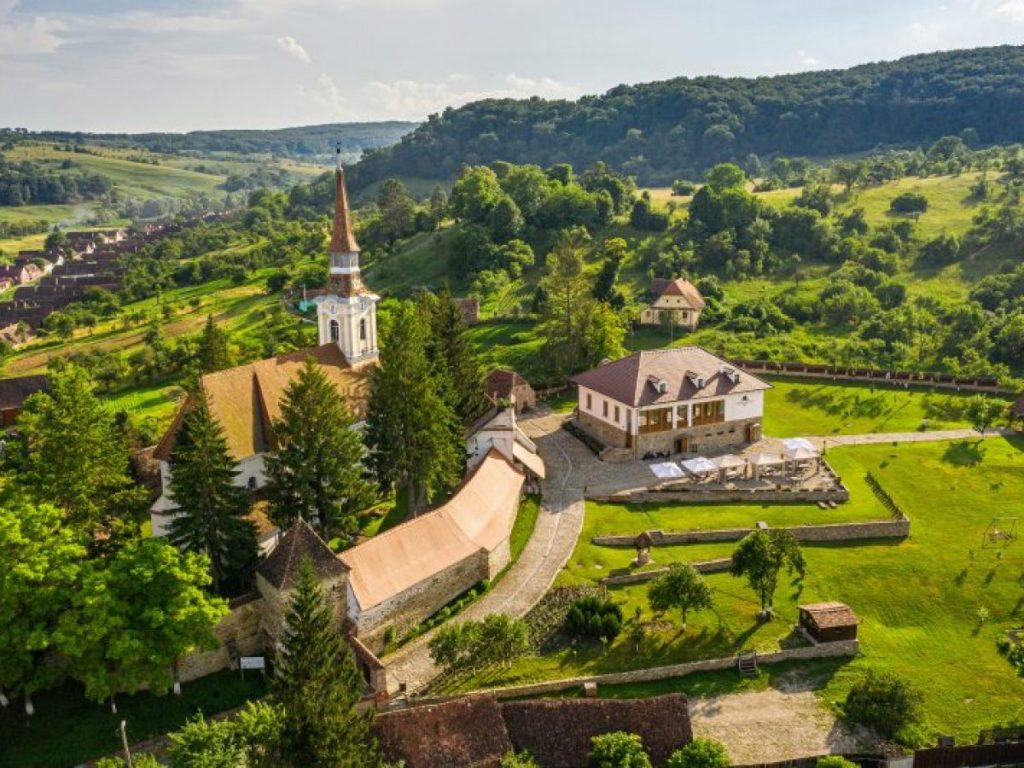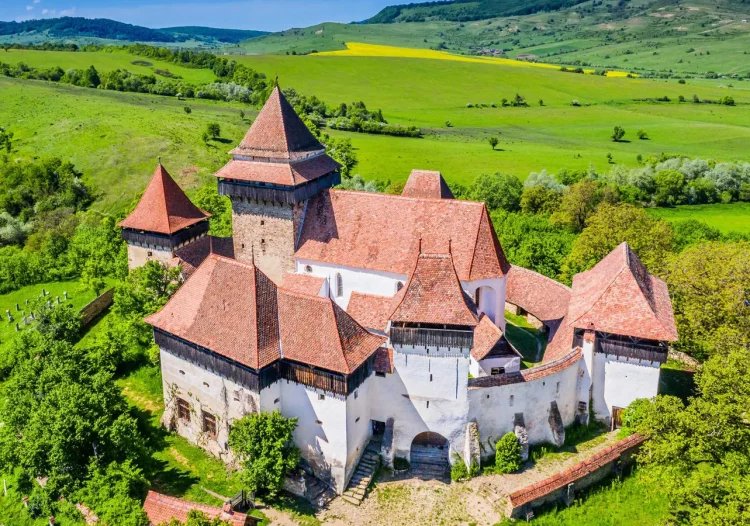When Gothic Aesthetic Meets Saxon Heritage
In 2024, an unexpected region started trending across global travel feeds: Romania’s Transylvanian countryside. But this wasn’t the typical Dracula-themed tour from decades past. Instead, this resurgence came wrapped in linen blouses, moody photography, and a TikTok aesthetic known as “Dark Academia.” The moody yet scholarly trend—which celebrates classical literature, candlelit libraries, and old-world mystery—has found its physical expression in the Saxon villages, fortified churches, and misty hills of Romania’s heartland. Now, travelers are arriving not just to visit Bran Castle, but to stay in centuries-old homesteads in Viscri, read Latin under gothic towers in Biertan, and photograph fog-drenched cobblestones at dawn.
Romania’s Transylvania region is no stranger to folklore and fairytales. But this time, its charm isn’t being defined by Hollywood vampires. It’s being rediscovered through a Gen Z lens—deeply visual, steeped in history, and refreshingly off the beaten path. The result is a travel renaissance for small towns that once lay forgotten on the fringes of European itineraries.
Viscri, Biertan, and the Saxon Soul of Transylvania
The foundation of this hype lies in the real cultural backbone of Transylvania’s countryside—its Saxon villages. Settled by German-speaking Saxons in the 12th century, towns like Viscri, Biertan, and Câlnic have preserved a unique blend of medieval architecture, Lutheran tradition, and defensive urban planning. In 2024, these villages aren’t just surviving—they’re thriving on a new form of tourism that values authenticity and cultural storytelling.
Viscri, now UNESCO-listed and protected, is the crown jewel. With its pastel-colored cottages, cobbled lanes, and perfectly preserved fortified church, it has become the go-to base for slow travelers. The village was also quietly popularized by King Charles III, who restored a house here and praised its connection to sustainable living and timeless rural rhythms.
TikTok videos showcasing Viscri’s fortified towers, wood-burning stoves, and horse carts have gone viral with millions of views. Influencers narrate poems over scenes of candlelit village dinners, adding an air of romanticism to what used to be overlooked as provincial. The town’s medieval ambiance, with no neon signage or concrete hotels in sight, makes it feel like a stage set for history itself.
Just a short drive away is Biertan, home to one of the most important fortified churches in Europe. Rising above the fog, its triple defensive walls and steep stone stairs have become iconic symbols of a region that resisted invaders with theology and masonry. The town itself, with its stone wells and craft markets, feels like an open-air museum—and visitors are flocking not just for the visuals but to attend traditional weaving classes and choir concerts held in the church nave.
How “Dark Academia” Aesthetics Made Rural Romania Cool
A major part of this resurgence comes down to aesthetics. The “Dark Academia” movement—which values vintage fashion, academic curiosity, gothic visuals, and literary escapism—found a living museum in Romania’s fortified towns. In early 2024, TikTok and Instagram creators began posting Transylvanian village tours styled like 19th-century gothic novels, pairing shots of mossy graveyards and candlelit reading corners with Chopin and Tchaikovsky. Hashtags like #TransylvanianAesthetic, #DarkTourism, and #AcademiaEurope exploded in popularity.
This new form of travel is less about bucket-list sightseeing and more about atmosphere and mood. It’s about journaling in a stone courtyard while sipping plum brandy, taking black-and-white film portraits in front of ivy-covered walls, or walking at dusk along forest paths that have remained unchanged for centuries.
The appeal runs deeper than looks. Dark Academia as a cultural wave is tied to introspection, history, and anti-commercialism—values that resonate strongly with Transylvania’s slower, more intentional pace of life. Here, you can rent a room in a 300-year-old guesthouse, eat heirloom tomato soup prepared by a local grandmother, and spend evenings reading by firelight. That’s the kind of immersive travel today’s culture-hungry explorers crave.

A Culinary Journey Through Forgotten Traditions
Food has also played a huge role in the region’s growing fame. Transylvanian cuisine is a hearty, multicultural affair influenced by Romanian, Saxon, Hungarian, and Roma traditions. Meals are rich in forest herbs, root vegetables, smoked meats, and wild mushrooms—often foraged and prepared with ancestral care.
In villages like Saschiz and Cund, travelers can now book slow food experiences where they learn to bake traditional cozonac (sweet walnut bread), distill țuică (fruit brandy), or ferment cabbage leaves for sour soups. Culinary tourists praise the communal style of eating and the lack of modern packaging—many meals are still served on painted ceramics, with ingredients picked from gardens just steps away.
2024 also saw the rise of “Transylvanian farm kitchens”—family-run outdoor dining rooms where guests sit under trellises while enjoying 6-course tasting menus of locally foraged and seasonal ingredients. The goal isn’t luxury but authenticity. These rustic meals have been picked up by international food bloggers, positioning rural Romanian dining as a quiet rival to Tuscany’s agritourism experiences.
Folklore and the Spiritual Undercurrent of the Landscape
The otherworldly beauty of Transylvania isn’t just visual—it’s psychological. The landscape is steeped in myth. From the eerie forests of Hoia Baciu to mountain legends of wolves and witches, Romanian folklore pulses beneath the surface of everyday life.
Travelers are beginning to embrace this aspect more openly in 2024. Folklore tours now include visits to ancient ritual sites, oral storytelling circles with local elders, and traditional music nights where songs recall long-lost pagan deities and village ghosts. These experiences, far from kitsch, are led by ethnographers and young locals reclaiming their cultural heritage.
The region’s deeper spiritual rhythm adds a layer of mystery that aligns with the global interest in “roots tourism.” Travelers are no longer content to visit a place—they want to understand it, even feel changed by it. In Transylvania, the blend of faith, legend, and landscape offers exactly that. Whether it’s lighting a candle in a wood-paneled church or hiking to a ruined fortress surrounded by ravens, the experience is as soulful as it is scenic.
Sustainable Tourism and a Fragile Balance
While the hype is welcomed by many locals—especially those reviving rural economies—there are concerns. Roads are narrow, infrastructure is delicate, and the risk of over-tourism looms. Fortunately, most villages have implemented visitor caps on popular festivals and strongly encourage travelers to stay at locally owned homestays. There are no chain hotels, no major franchises, and little appetite for mass tourism.
Romania’s rural tourism strategy, led in part by NGOs and cultural preservation groups, focuses on “heritage first” development. Rather than modernizing the aesthetic, the goal is to protect it. This includes restoring wooden barns into guest houses using traditional carpentry, maintaining cobbled roads with historic materials, and supporting local artisans through fair trade markets.
In 2024, a growing number of Transylvanian villages have joined international networks like “Slow Cities” and “Cittaslow,” signaling their commitment to responsible growth. This means visitors not only have a more intimate experience—they also help sustain a cultural treasure that has too often been neglected.
Conclusion: Why Romania’s Villages Are More Than a Trend
The hype around Transylvania’s countryside in 2024 isn’t just about viral visuals or gothic trend cycles. It’s about a return to groundedness. In a hyper-digitized world, these villages offer something raw, real, and restorative. They invite you to slow down, read a book, eat a meal grown from the soil beneath your feet, and sit under a walnut tree with people who know your name.
For younger travelers raised on fast content and filtered lives, this contrast feels radical. It’s not about escape—it’s about reconnection. Transylvanian villages, once footnotes in medieval history, have become the quiet stars of a new kind of travel story—one written in stone, shadow, and silence.





















